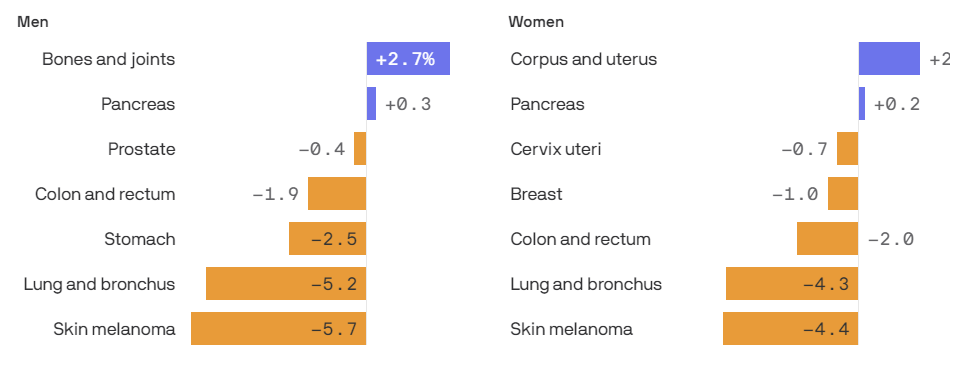Death rates for many individual cancer types, such as melanoma, have seen historic drops in the last decade, writes Axios. A few, like pancreatic cancer, have remained stubbornly unchanged. Others, like colorectal cancer, have seen worrisome increases.
The big picture
Between 2000 and 2021, cancer death rates in the US dropped 27%, from 196.5 to 144.1 deaths per 100,000 people.
Much of that progress occurred after the human genome was sequenced, allowing major changes in how we understand cancer, screen for it, and ultimately treat it with personalised therapies, experts say.
Where the advent of immunotherapies expanded treatments, there's been particular success with some lung and blood cancers and melanoma, said Karen Knudsen, CEO of the American Cancer Society.
There’s also been a reframing of the goals in cancer treatment from curing the disease at any cost to preserving a patient’s quality of life. “The goal is to turn cancer into a chronic disease rather than a fatal one,” Bryan McIver, the Moffitt Cancer Center's deputy physician-in- chief, told Axios.
Yes, but there’s still a lot of work to do. Cancer was the second leading cause of death after heart disease in 2020, killing 602,350 people. (COVID-19 was the third leading cause of death, according to the US Centers for Disease Control and Prevention (CDC).)
Here’s what the experts told Axios about progress on a few major types
of cancer:
Lung cancer: It's still the number one cause of cancer deaths, accounting for roughly 136,000, or about 23%, of cancer deaths in the US in 2020, per CDC data.
However, there’s real progress. Certain types of lung cancer are highly receptive to immunotherapy and can be managed with an oral pill, McIver said. Effective prevention strategies, like getting people to stop smoking and screening for those at higher risk, are gaining traction – although too slowly, Knudsen told Axios. ”For lung cancer, early detection can make quite a difference,” but she noted that the screening uptake for lung cancer is low. “It's a screaming call to action.”
Colorectal cancer: This is the second most common cause of cancer deaths in the US, making up roughly 52,000, or 9%, of cancer deaths in 2020.
But while incidence is becoming less common for those over 50, there’s been an increase in early-onset colorectal cancer, leading the US Preventative Services Task Force last year to lower the recommended age of first screening from 50 years old to 45. People under 50 “are more likely to be diagnosed with advanced disease, which is concerning because we don’t fully understand the reason why”, Knudsen said.
Researchers are examining whether factors such as diet, bacteria in the gut and inflammation might be factors.
”We need to better understand what it is that is different about the very youngest patients,” Kimmie Ng, director of the Dana-Farber’s Young-Onset Colorectal Cancer Center, told Axios.
Breast and prostate cancer: Female breast cancer and prostate cancer in men are the fourth and fifth leading causes of cancer death in the US (both come after pancreatic cancer, which had “disappointingly” few advances, according to McIver.)
One of the biggest steps forward in breast cancer was the recognition that there are at least five different subtypes with different genetic drivers, which therefore need different and more targeted treatments.
“The parallel cancer with which we havenʼt had the same success is prostate cancer,” Knudsen said. Different subtypes haven’t been discovered in the same way, and while it has a high chance for being cured when caught at an early stage, screening remains low.
It’s particularly troublesome because certain ethnic groups, such as African American men, who are at higher risk for prostate cancer, are less likely to catch it early. “We’ve still got to work on making access to screening more widely available,” McIver said.
Melanoma and cervical cancer: There were an estimated 6,900 deaths in America from melanoma in 2020. But with melanoma death rates declining an average of 7% per year for adults younger than 50 between 2013 and 2017, it’s become a poster child for progress.
“In the past, if you had Stage 4 malignant melanoma, your survival was measured in months and all the chemotherapy we could throw at you wouldn’t extend that life,” McIver said. With forms of immunotherapy, patients have gone into “complete remission” for years, McIver said. “It’s truly transformational stuff.”
Knudsen also attributes the drop in deaths to a steady reduction in incidence since 2005, attributing this to preventative steps like sunscreen use.
Another potential success story: The effectiveness of the HPV vaccine as a “cancer vaccine”, Knudsen said. “If we hit the expected potential uptake in HPV vaccination, we will all but eliminate cervical cancer and about 50% of head and neck cancers,” she said.
The bottom line
“The pattern of cancers has continued to evolve over time, and some of it is about the environment in which we live and our habits,” said McIver. There’s still a lot to be optimistic about, but there’s a lot of work to be done, he added.

Axios article – The fast-changing survivability of cancer (Open access)
See more from MedicalBrief archives:
Stopping smoking after lung cancer diagnosis may boost survival by nearly 30%
Fatty acid in palm oil linked to metastasis in mouth and skin cancers — Animal study
HPV vaccine cuts cervical cancer by nearly 90% — UK population registry study
Stopping smoking before 45 can wipe out 87% of lung cancer risk
Antibiotic use linked to increased risk of colon cancer — Swedish Colorectal Cancer Registry

